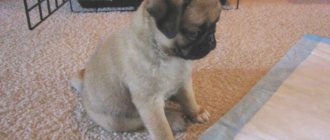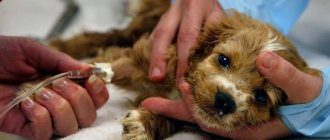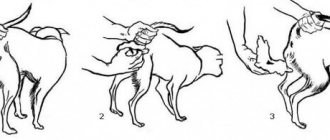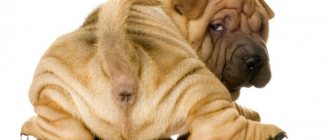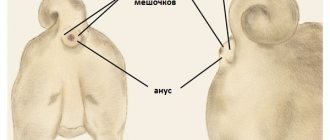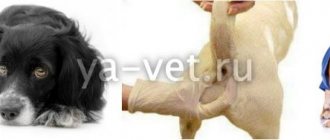Answer
Colitis is an inflammatory disease of the colon and is a common disease in dogs. Physiologically, the large intestine in dogs is located above the small intestine, the work is aimed at performing the following functions:
- Absorption of liquids;
- Residual digestive process;
- Removal of metabolic products.
Colitis is thought to be caused by a high percentage of bacteria inside the colon. The described disease is not contagious to other living organisms.
Differentiation of colitis by forms:
- Catarrhal;
- Atrophic;
- Erosive-ulcerative;
- Catarrhal-ulcerative.
Colitis is often a chronic pathology, most often diagnosed in boxers, sharpeis, English and French bulldogs.
Causes of Constipation in Dogs
Constipation is understood as difficulty in defecation; in severe cases, independent excretion of feces is impossible. The pathology can be associated with any disease that increases the absorption of fluid from the intestine or reduces its motor function. There are many reasons for constipation in dogs:
- feed (grass, bones, lack of fiber);
- toxins and drugs;
- pathologies of the endocrine system and metabolism;
- physical inactivity;
- intestinal obstruction;
- rectal diseases.
Infrequent defecation is observed in dogs with low activity. Physical inactivity leads to a decrease in intestinal motor function; feces move more slowly, which increases their density. Changes in the environment can affect the frequency of defecation, for example, dogs are reluctant to go into a dirty tray during stressful situations (transportation, veterinary procedures).
Pathologies of the rectum and surrounding tissues lead to pain during bowel movements. This may cause a decrease in the frequency of bowel movements. Such diseases include perianal fistulas, abscesses and foreign bodies in the rectum, and damage to the pelvic bones.
Constipation is a pathological symptom of another pathology, the establishment of which is of paramount importance for the choice of treatment.
Difficulty in moving feces through the intestines is associated with increased absorption of water or decreased contractile function. This is caused by metabolic diseases, diseases of the central nervous system, poisoning with various drugs and other drugs. Establishing the etiology is the main point in the treatment of chronic forms of constipation.
Causes
- Incorrect and poor quality nutrition;
- Allergic reaction;
- Harmful bacterial activity;
- Age-related changes;
- Colonization by helminths, lamblia and nematodes;
- Intestinal obstruction caused by objects stuck in the intestines.
Often the likelihood of colitis increases many times if the pet likes to eat grass - fibers that are not digested by the dog’s body irritate the walls of the large intestine.
Microorganisms and fungi provoke infections in dogs, which causes acute pain in the dog’s intestines and inflammation in the colon.
Stress is the cause of many diseases, including attacks of colitis. Taking antibiotics causes irritable bowel syndrome: drugs whose action is aimed at destroying harmful microflora, among other things, affect the body’s own microflora. Eating abuse is the reason leading to chronic colitis.
Inflammation of the colon also provokes a number of diseases: pancreatitis, gastroenteritis, colon cancer.
Signs
Symptoms of fecal incontinence:
- Insufficient ability of the colon and rectum to retain feces.
- Urge to defecate; frequent, conscious defecation, without fecal leakage; defecation may be associated with straining (tenesmus); difficulty defecating (dyschezia) or blood in the stool.
- Pain or tenderness in the anus during physical examination of the lower bowel; an anal or rectal mass or thickening of the rectal mucosa may be detected; The external anal sphincter (the ring of muscle that opens and closes the anus) and the anal reflex are normal.
Non-nervous system incontinence can be caused by injury to the skin and tissues surrounding the anus (perianal tissues) or deep infection of these tissues, including the skin surrounding the anus with extensive perianal fistulas. In this case, the anal reflex is present, but the external anal sphincter may not close completely if there is structural damage to the sphincter.
Nervous system incontinence is characterized by involuntary bowel movements, especially during times of agitation, barking or coughing. There may be a loss of external anal muscle tone, but this tone is a poor indicator of sphincter function; the anal reflex is absent or reduced.
The presence of urinary incontinence (lack of urinary control) in addition to fecal incontinence indicates that the incontinence is related to the nervous system.
Findings suggestive of spinal cord disease include loss of voluntary movement and tail tone; pain in the spinal column near the tail; partial or complete paralysis, characterized by flabby muscles (lack of muscle tone) of the hindquarters and hind legs; decreased response when testing hind paw reflexes.
Symptoms of colitis
Stomach upset, which is not an occasional occurrence, is the main symptom that makes the dog owner think about an urgent visit to the doctor. Loose stools with blood and mucous discharge indicate that the disease has reached an acute stage, requiring immediate intervention by a veterinarian.
Warning signs:
- Pain in the gastrointestinal tract;
- Gas release and belching;
- The pet's tongue is covered with a grayish coating;
- Exceeding normal body temperature;
- Cardiopalmus;
- Rumbling sounds in the intestines, unpleasant odors in the dog’s mouth;
- Rapid weight loss for your pet;
- Unaccustomed animal craving for grass.
Chronic colitis is not always clearly characterized by the given symptoms. It is worth taking into account the fact that such a clinical picture is typical for internal, infectious diseases.
Delay and untimely initiation of treatment for colitis causes complications in the form of ulcerations of the colon mucosa, the occurrence of erosions and its further transition to the stage of a chronic disease.
Other reasons
In addition, the “colonization” of the dog’s intestines with worms can result in a similar outcome. If there are many of them, the bodies of the worms completely block the lumen of the intestines and prevent the chyme from moving further. In this case, the course of the disease is even more severe, since the body receives a double dose of toxins: the first from worms, and the second from decomposing feces.
There are also more exotic reasons. In particular, dogs that have survived falls from heights, hits from cars or bicycles, and who were lucky enough to get to a good veterinary surgeon who assembled the animal’s pelvis literally piece by piece, often experience adhesive disease. Sometimes there are so many adhesions and they are so hard that the overgrown connective tissue literally compresses half of the organs of the pelvic cavity. The natural result is coprostasis.
Don't forget about oncology. Any tumor, benign or malignant, if it is of the appropriate size, can easily block the intestinal lumen completely. Finally, there are dogs that, no matter how much you feed them, cannot be pulled away from the trash heaps by their ears. Their intestines sometimes accumulate so much trash in the form of bags, sausage wrappers, hair and hooves that the development of coprostasis becomes only a matter of time.
Diagnosis of colitis
Diagnostic measures are carried out in stages:
- Examination in a clinical setting;
- Laboratory research. Collection of blood, urine and feces for testing. The results of the study can provide the attending physician with a complete picture of the dog’s health, in particular the condition of the intestinal walls;
- Morphological studies.
Hardware methods for detecting diseases of the gastrointestinal tract of animals.
Radiography. The examination is carried out using a fluoroscope and a series of x-rays. Before the start of the process (two hours before) of taking an x-ray, a barium suspension is injected into the pet’s body. The movement of the substance through the gastrointestinal tract reveals various deviations in the morphological structure of organs: changes in the number of folds of the intestinal lining, disturbances in motor and other functions. The form of colitis is revealed through the study of the relief of the mucous membrane of the large intestine.
Intestinal biopsy. Laparoscopy is a minimally invasive surgical procedure in which a veterinarian inserts a rigid endoscope through the abdominal wall into the animal’s abdominal cavity. The method allows for accurate diagnosis and assessment of the condition of intestinal tissues and other organs of the gastrointestinal tract.
Why fecal incontinence occurs in dogs: causes and symptoms
Dogs are very conscientious creatures. They will not defecate in the house unless there is a problem. This most often happens to older pets, but there are also medical pathologies that lead to loss of the ability to feel bowel movements.
The main causes of involuntary bowel movements:
- spinal cord disease or injury;
- a nervous disorder that interferes with the sphincter's ability to function;
- infection or abscess of the anal sacs;
- muscle damage - the anal reflex is absent or weakened;
- worms and protozoan parasites;
- poor nutrition;
- taking medications;
- perianal fistula.
Gastrointestinal diseases also lead to problems with bowel movements, but they do not necessarily become a sign of fecal incontinence. However, gastrointestinal diseases often cause weight loss, vomiting, spasms of the genitourinary diaphragm and the desire to empty the intestines or bladder.
Important! Incontinence is a condition in which the pet is unaware of what has happened. If he tried to sit down and poop, then this is difficulty in defecating. The causes of these pathologies are different.
If your dog has any of these symptoms, he should be taken to the vet:
- defecation in random places in the room;
- passing feces while walking or sleeping;
- bloated belly;
- increased gas formation;
- diarrhea;
- lack of muscle tone in the anus area;
- does not allow you to touch the tail or, on the contrary, vigorously wipes your butt on various objects;
- Unusual tail movements were observed.
Injuries
Animals are often injured during fights or accidents. This can result in paralysis or weakening of the hind legs. If the anus is damaged or an abscess develops, it may be difficult for your pet to control bowel movements.
Operations
The anal muscles or sphincter can be damaged not only during injury, but also during anal surgery. To treat such a problem, another operation will be required. In addition, in the postoperative period, all animals do not control bowel movements, so it will take several months to restore function.
Diarrhea
Diarrhea causes a number of reasons - infections, parasites, chronic diseases, etc. If the volume of feces produced exceeds the capacity of the intestines, then this immediately becomes the cause of involuntary bowel movements.
Infectious diseases
Inflammatory processes in the colon can also cause fecal incontinence.
The following lead to the same effect:
- perianal fistula;
- chronic diseases around the anus;
- infections near the anus;
- colon irritation;
- spinal tumors.
Important! Urinary tract infection
—
this is the most common cause of incontinence. Problems also arise from bladder stones.
Nerve and muscle disorders
Various disorders of the nervous system lead to incontinence:
- spinal cord diseases (degenerative myelopathy);
- defects of the musculoskeletal system (spinal dysraphism), pinched intervertebral discs;
- damage to nerve endings (myopathy);
- blockage of spinal cord vessels;
- inflammation of the spinal cord;
- hernia;
- infection or disease of the intervertebral discs.
Aging
As a result of age-related changes in the body, the following are possible:
- disturbances in the functioning of the muscles that are responsible for the act of defecation;
- muscle atrophy.
The muscles weaken and stop performing their functions, which leads to loss of control over feces.
The dog rides on its butt: paraanal glands
The anal sacs (anal sinuses) of dogs are paired skin diverticula that form a reservoir and excretory canal into which the apocrine and sebaceous glands flow. The release of the contents of the anal glands, in the absence of any pathologies, occurs naturally, during contraction of the anal sphincter, with each act of defecation. Unfortunately, dogs are often diagnosed with diseases of the anal sacs, which manifest themselves in the form of blockages, infections, and abscesses. In addition, many skin pathologies develop against the background of blockage of the paraanal sinuses.
When the anal glands are blocked, an enlarged and severe reddening of the anus is noted due to excessive filling of the anal sacs. When pressing on the area of the paraanal diverticula, a dark brown liquid without a pungent odor is released from the anus. In the case of chronic inflammation, the contents have a putrid, pungent odor, hair in the anal area may fall out or stick together, the coat is faded and tousled. Dogs experience severe itching, ride on their butts, feel restless, often look back at the croup, gnaw the tail, croup area, and hind limbs, thus trying to free the filled glands from secretions. In particularly severe cases, tail pyoderma is possible. Scratching, wounds, and damage to the epidermis are noticeable in the croup area. This pathology can only be eliminated by cleaning and removing the contents of the anal sacs. Inspection of the condition and degree of filling of the paraanal glands is carried out every three to four months.
The reasons for blockage of the anal sacs can be of a very different nature, ranging from congenital pathologies in the structure and ending with too much thickness of the secretion. This condition can also develop due to impaired intestinal motility, a weakened immune system, untimely emptying of the intestines or bladder, poor-quality feeding of dogs, injuries, infectious diseases, and helminthiasis.
To prevent these problems from occurring, you need to regularly inspect and clean the anal glands. Since the procedure is not very aesthetic, it is best to seek help from a veterinarian. In terms of time, cleaning the paraanal glands does not take more than 10 minutes. If necessary, the veterinarian will perform preventive rinsing of the excretory ducts with antiseptic solutions. Having experience, it is quite possible to clean the paraanal sinuses yourself.
This procedure is best carried out outdoors, in a quiet, deserted place, always with an assistant who will securely hold the pet. Wearing sterile rubber gloves, lubricated with grease, neutral cream or Vaseline, an index finger is inserted into the dog's anus. Using your thumb on the outside and your index finger on the inside, you need to feel the location of the paraanal glands, which will have a pear-shaped, dense consistency. If compared to a watch dial, the glands will correspond to 5-7 o'clock. Using gradual massaging movements, first on one side, then on the other, you need to lightly press on the gland, moving it closer to the back and achieve the release of secretions by pressing effortlessly on the anal area. After cleaning, for the next two to three days, it is recommended to administer antibacterial and anti-inflammatory rectal suppositories to the dog for prevention. Of course, it is best for your veterinarian to show you how to properly clean the anal sinuses the first time.
You can also clean the anal sinuses using a simpler, external method. Press the napkin to the anus, and squeeze both sides of the anal area with a sharp movement. However, a more effective method, especially if the secretion is quite viscous and thick, is only possible using the rectal method. If necessary, the anal sacs are cleaned again, two to three days after the first procedure. If persistent blockage of the anal glands occurs, surgical removal of the anal sacs is recommended.
Why does a dog ride on its butt?
If you notice that your pet eats on its butt after defecation or at any other time, as already noted, one of the reasons for this strange behavior may be a blockage, an excessive accumulation of secretion in the paraanal sinuses. When they are overfilled, the dog experiences discomfort, often chews out the area of the croup, tail, hind limbs, “rides” on the butt to independently stimulate the release of secretions from the glands, or “hunts” for its own tail. The reason for this behavior is also severe helminthic infestation, irritation of the anus with feces, which often occurs with profuse diarrhea. When blocked. Inflammation of the paraanal sinuses makes defecation difficult; the dog experiences pain during bowel movements and even when walking. If you notice characteristic. symptoms listed above, clean the paraanal sinuses and show your pet to a veterinarian.
